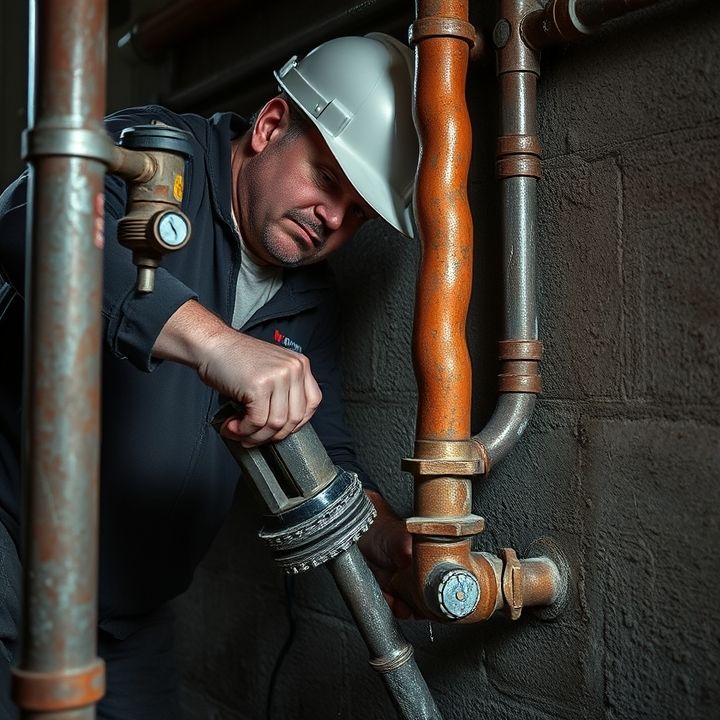Table of Contents
- Introduction
- Identify the type of plumbing emergency
- Turn off the main water supply
- Assess the damage and potential risks
- Contact a professional plumbing emergency service
- Document the situation with photos
- Follow safety precautions to prevent further issues
- Begin initial cleanup to mitigate damage
- Plan for necessary repairs and maintenance
- Conclusion
- Frequently Asked Questions
Introduction
Imagine this: it’s a quiet evening at home, and suddenly, you hear the unmistakable sound of running water where it shouldn’t be. Panic sets in as you rush to the source, realizing you’re faced with a plumbing emergency. Whether it’s a burst pipe, a flooded basement, or a malfunctioning water heater, such disasters can create chaos and overwhelming stress. But fear not! Knowing how to respond effectively can make all the difference between minor inconvenience and major disaster.
In this guide, we’ll explore the essential steps to take when plumbing emergencies strike. With the right knowledge and quick actions, you can minimize damage and restore order to your home. Each moment counts, and being prepared is key to handling these urgent situations with confidence.
Identify the type of plumbing emergency
Identifying the type of plumbing emergency is the first step in effectively managing the situation. Common types of plumbing emergencies include burst pipes, clogged drains, overflowing toilets, and water heater failures. Each type of emergency requires a different approach and urgency level.
For instance, a burst pipe can cause extensive water damage, so immediate action is necessary to shut off the water supply and minimize flooding. On the other hand, a clogged drain may not present an immediate threat but can lead to more significant issues if not addressed quickly.
Overflowing toilets are another urgent problem, as they can lead to unsanitary conditions and damage to flooring. It is essential to turn off the water supply to the toilet and seek solutions promptly. Understanding the nature of the plumbing issue allows homeowners to act decisively, whether that means attempting a quick fix or calling a professional plumber to assess and resolve the problem effectively.
Turn off the main water supply
In the event of a plumbing emergency, the first and most crucial step is to turn off the main water supply. This action can prevent significant water damage and help you control flooding in your home. The main water shut-off valve is typically located near where the water line enters your home, whether in the basement, crawl space, or on an exterior wall.
Once you’ve located the valve, turn it clockwise to shut it off. If you’re having difficulty finding the valve, consult your home’s plumbing plans or ask a neighbor with a similar home layout.
After shutting off the main water supply, it’s essential to relieve any pressure in the pipes. You can do this by turning on the highest faucet in your home and letting it run until the water stops flowing. This not only helps in reducing the risk of further leaks but also allows you to address the issue at hand without the worry of more water entering the system. Preparing for future plumbing emergencies by knowing the location of the shut-off valve can save you time and money.
Assess the damage and potential risks
In a plumbing emergency, the first step is to assess the damage and potential risks associated with the situation. Identifying the source of the problem is crucial. Is it a burst pipe, a clogged drain, or a malfunctioning toilet? Understanding the type of issue you are facing can help you take appropriate action.
Another important factor to consider is the extent of the water damage. Check for signs of water pooling, dampness on walls or floors, and any visible leaks. This will not only help you understand the immediate risks but also assist in determining whether you can manage the situation yourself or need to call a professional.
Additionally, consider the potential risks of mold growth and structural damage that can occur if water is left unmanaged. This is especially pertinent in areas that are prone to moisture. Always prioritize safety; if the damage is severe or poses risks such as electrical hazards, evacuate the area and seek professional help immediately. Taking these initial steps can minimize further complications and help you handle the emergency more effectively.
Contact a professional plumbing emergency service
In the event of a plumbing emergency, one of the most critical steps to take is to contact a professional plumbing emergency service. These services specialize in addressing urgent plumbing issues, such as severe leaks, burst pipes, or overflowing toilets. When you call an emergency plumber, you will often benefit from their 24/7 availability, ensuring that you can get assistance at any hour, day or night.
Professional emergency plumbers come equipped with the necessary tools and expertise to quickly diagnose and resolve plumbing problems. This not only minimizes potential damage to your property but also guarantees that the issue is addressed safely and effectively. Attempting to fix a severe plumbing issue without professional help can lead to more complications or even exacerbate the problem.
Moreover, licensed emergency plumbers are insured and bonded, providing you with peace of mind that the work will be completed to high standards. In summary, contacting a professional plumbing emergency service will be a proactive approach that saves time, money, and stress during a plumbing crisis.
Document the situation with photos
In any plumbing emergency, documenting the situation with photos can be incredibly helpful for a number of reasons. First, photographs provide visual evidence of the extent of the damage, which can be beneficial when filing an insurance claim. Insurance companies often require documentation to assess the situation accurately. Thus, having clear images can expedite the claim process.
Additionally, taking photos can help professionals understand the problem better before they arrive on-site. When hiring a plumber, providing them with images can assist in diagnosing the issue and may lead to a more efficient repair. Furthermore, these records can serve as a reference for future repairs or maintenance.
While capturing images, be sure to photograph not only the damaged area but also any related fixtures or appliances that might be affected. This thorough documentation will ensure that you have all necessary information to address any complications that arise in the plumbing emergency.
Follow safety precautions to prevent further issues
In the event of a plumbing emergency, following safety precautions can prevent further issues and protect both your home and personal safety. First and foremost, turn off the water supply to limit damage. Locate the main shut-off valve, which is usually found near the water meter, and turn it clockwise to stop the flow of water. If there is a risk of electrical hazards, ensure all affected electrical devices are unplugged and, if necessary, turn off the power supply to the area until it is safe.
Additionally, consider wearing protective gear such as gloves and goggles to shield yourself from potential contaminants or sharp objects. If the emergency involves sewage or waste water, avoid contact and stay clear of the affected area.
It is important to contain the problem as much as possible by using towels or buckets to soak up excess water, but never hesitate to call a professional plumber if the issue is beyond your control. Being prepared and following these safety measures can make a significant difference in managing a plumbing emergency effectively.
Begin initial cleanup to mitigate damage
In the event of a plumbing emergency, beginning initial cleanup is critical to mitigate damage. The first step is to identify the source of the leak or flooding and stop it if possible. This may involve turning off the main water supply to prevent further water flow. Once the immediate threat is under control, it is essential to start removing any standing water as quickly as possible. You can use mops, buckets, or a wet/dry vacuum to assist with this process.
Next, focus on salvaging personal belongings and important documents that may be affected by the water. Move items to a safe, dry area to prevent further damage. Be cautious when handling electrical appliances or cords that may have come into contact with water, and disconnect power if necessary.
Once the area is clear, drying the space is vital to prevent mold growth. Open windows, use fans, or dehumidifiers to facilitate airflow and reduce moisture. By taking these initial cleanup steps, you can significantly minimize the long-term effects of a plumbing emergency.
Plan for necessary repairs and maintenance
Planning for necessary repairs and maintenance is crucial in managing plumbing emergencies effectively. Regular inspections can help identify potential issues before they escalate into major problems. Homeowners should create a maintenance schedule that includes checking for leaks, inspecting faucets, and assessing the condition of pipes and fixtures. This proactive approach also involves having the contact information for licensed plumbers readily available for emergencies.
Additionally, it’s wise to familiarize oneself with the plumbing system in the home, understanding where the main shut-off valve is located and how to use it. Knowing how to temporarily stop leaks with items such as plumber’s tape or pipe clamps can also be beneficial. To prevent emergencies, homeowners should address minor issues promptly. Ignoring small leaks or slow drains can lead to larger, more costly repairs down the line. Lastly, investing in high-quality plumbing fixtures and maintaining them properly can greatly reduce the likelihood of plumbing emergencies.
Conclusion
In conclusion, knowing how to effectively manage plumbing emergencies is vital for every homeowner. By following the essential steps outlined in this article—identifying the type of emergency, turning off the main water supply, assessing the damage, and contacting professional assistance—you can significantly minimize damage and stress during a crisis. Remember to document the situation, follow safety precautions, and begin the initial cleanup process as soon as possible. Most importantly, don’t hesitate to reach out for professional help when needed; addressing plumbing emergencies promptly can save you from more extensive repairs in the long run. If you find yourself facing a plumbing disaster, don’t wait until it’s too late. Call 573-555-2121 now for expert plumbing assistance and ensure your home gets the help it needs to recover swiftly.

